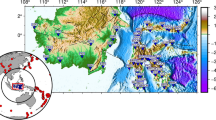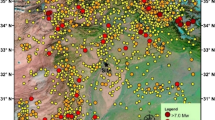Abstract
The Uttarakhand Himalaya which comprises of the Garhwal and Kumaon Himalaya lies in the central seismic gap region of India. Strong motion networks have been installed separately in the Garhwal and Kumaon Himalaya under various sponsored research projects funded by the Department of Science and Technology (DST) and Ministry of Earth Sciences (MoES). These networks have recorded several near field earthquakes in the recent past. Recorded data from these networks have been utilised to study the crustal attenuation characteristics of these two regions. The crustal attenuation characteristics of medium can be directly estimated from the frequency dependent quality factor ‘Q’. Estimation of shear wave quality factor, coda wave quality factor and attenuation relations have been made by using same methodology in the data set obtained separately from these two regions. It has been found that there is a substantial difference in the attenuation characteristics of the crustal rocks in these two regions. Since shear wave attenuation has a close relation with the shear wave velocity, therefore, the shear wave velocity has been estimated at various locations of the Garhwal and Kumaon Himalaya by both active and passive methods. It has been found that the average shear wave velocity of crustal rocks in the Garhwal Himalaya is comparatively higher than that in the Kumaon Himalaya which clearly support the high attenuation property of the crustal rocks in the Kumaon Himalaya compared to the Garhwal Himalaya.
Similar content being viewed by others
References
Aki, K. and Chouet, B. (1975) Origin of Coda waves: Source, Attenuation and Scattering Effects. Jour. Geophys. Res., v.80, pp.3322–3342.
Castellaro, S. (2016) The complementarity of H/V and dispersion curves. Geophysics, v.81, pp.1–16.
Castellaro, S. and Mulargia, F. (2009) VS30 Estimates Using Constrained H/V Measurements, Bull. Seismol. Soc. Amer., v.99(2A), pp.761–773.
GSI (2000) Seismotectonic atlas of India and its environs. In: Dasguta, S., Pande, P., Ganguly, D., Iqbal, Z., Sanyal, E. Venkatraman, N. V., Dasgupta, S., Sural, B., Harendra Nath, L. Majumdar, K., Sanyal, S., Roy, A., Das, L.K., Mishra, P. and Gupta, H.K. (Eds.), Geological Society of India, no.46.
Gupta S.C., Singh V.N., Kumar A. (1995) Attenuation of coda waves in the Garhwal Himalaya, India. Phys. Earth Planet. Interiors, v.87, pp.247–253
Joshi A. (2006) Use of acceleration spectra for determining frequency dependent attenuation coefficient and source parameters, Bull. Seismol. Soc. Amer., v.96, pp.2165–2180.
Joshi A. (2007) Inversion of seismic Intensity data for the determination of three dimensional attenuation structures in the central gap region of Himalayas, Natural Hazards, v.43, pp.129–146.
Joshi, A., Ashvini Kumar, Heriberta Castanos and Cinna Lomnitz (2013) Seismic Hazard of the Uttarakhand Himalaya, India, From Deterministic Modeling of Possible Rupture Planes in the area, Internat. Jour.f Geophys., Article ID 825276, 12p. doi:https://doi.org/10.1155/2013/825276
Knopoff, L. (1964), Q, Rev. Geophys., v.2, pp.625–660.
Kumar, P., Joshi, A., Sandeep and Ashvini Kumar (2015a) Three-dimensional attenuation structure in the region of Kumaon Himalaya, India based on inversion of strong motion data. PAGEOPH, v.172, pp.333–358.
Kumar, P., Joshi, A., Kumar Ashvini, Chadha, R.K. (2015b) Detailed Attenuation Study of Shear Waves in the Kumaon Himalaya, India, Using the Inversion of Strong Motion Data. Bull. Seismol. Soc. Amer., v.105(4), pp.1836–1851.
Kumar, A., Sinvhal, A., Joshi, A., Kumar, D., Sandeep and Kumar, P. (2015c) Coda wave attenuation characteristics for Kumaon and Garhwal Himalaya, India. Natural Hazards, v.75(2), pp.1057–1074.
Lin, C.M., Chang, T.M., Huang, Y.C., Chiang, H.J., Kuo, C.H., and Wen, K.L. (2009) Shallow S-Wave Velocity Structures in the Western Coastal Plain of Taiwan. Terrestrial, Atmospheric & Oceanic Sciences, v.20(2), pp.299–308.
Mandal, P., Padhy, S., Rastogi, B.K., Satyanarayana, V.S., Kousalya, M., Vijayragvan, R. and Srinivasan, A. (2001) Aftershock activity and frequency dependent low coda Qc in the epicentral region of the 1999 Chamoli earthquake of Mw 6.4. PAGEOPH, v.158, pp.1719–1735.
McMechan, G. A. and Yedlin, M.J. (1981) Analysis of dispersive waves by wave field transformation. Geophysics, v.46, pp.869–874.
Midorikawa, S. (1980) Prediction of intensity distribution due to major earthquakes with regard to fault rupture and site ground conditions. In proc. 8th symposium on ground vibration. Architectural Institute of Japan, pp.59–64 (in Japanese).
Mukhopadhyay, S. and Sharma, J. (2010) Attenuation characteristics of Garwhal-Kumaun Himalayas from analysis of coda of local earthquakes. Jour. Seismol., v.14, pp.693–713.
Negi, S.S., Ajay Paul, Anand Joshi and Kamal, (2015) Body Wave Crustal Attenuation Characteristics in the Garhwal Himalaya, India, PAGEOPH, v.172, pp.333–358.
Paul, A. Gupta S.C. and Pant C.C. (2003) Coda Q estimates for Kumaon Himalaya. Proc. Indian Acad. Sci. (Earth Planet. Sci.), v.112, pp.569–576.
Sharma, B., Teotia, S.S., Kumar, D. and Raju, P.S. (2009) Attenuation of P- and S-waves in the Chamoli Region, Himalaya, India, Pure Appl. Geophys., v.166, pp.1949–1966.
Singh, S.K., Mena, E., Castro, R., and Carmona, C. (1987) Empirical prediction of ground motion in Mexico City from coastal earthquakes. Bull. Seism. Soc. Amer., v.77(5), pp.1862–1867.
Acknowledgement
Authors thank Dr. H.K. Gupta and Dr. Sandeep Singh for invitation to contribute this paper. Authors also thank IIT Roorkee for providing all the necessary support required for the research presented in this paper. Research work presented in this paper is the outcome of project grant no. DST/Seismo/23(483)/2004, SR/S4/ES-596/2011, EMR/2015/002500, MoES/P.O. (Seismo)23(483)/2004, MoES/P.O. (Seismo)(42)/2009, MoES/P.O. (Seismo)/1/(203)/2013 and MoES/P.O. (Seismo)/1(325)/2017, respectively.
Author information
Authors and Affiliations
Corresponding author
Rights and permissions
About this article
Cite this article
Joshi, A., Pandey, M. Differential Crustal Attenuation in the Garhwal and Kumaon Himalaya Obtained from Seismological and Geophysical Studies. J Geol Soc India 98, 79–82 (2022). https://doi.org/10.1007/s12594-022-1932-2
Received:
Accepted:
Published:
Issue Date:
DOI: https://doi.org/10.1007/s12594-022-1932-2




